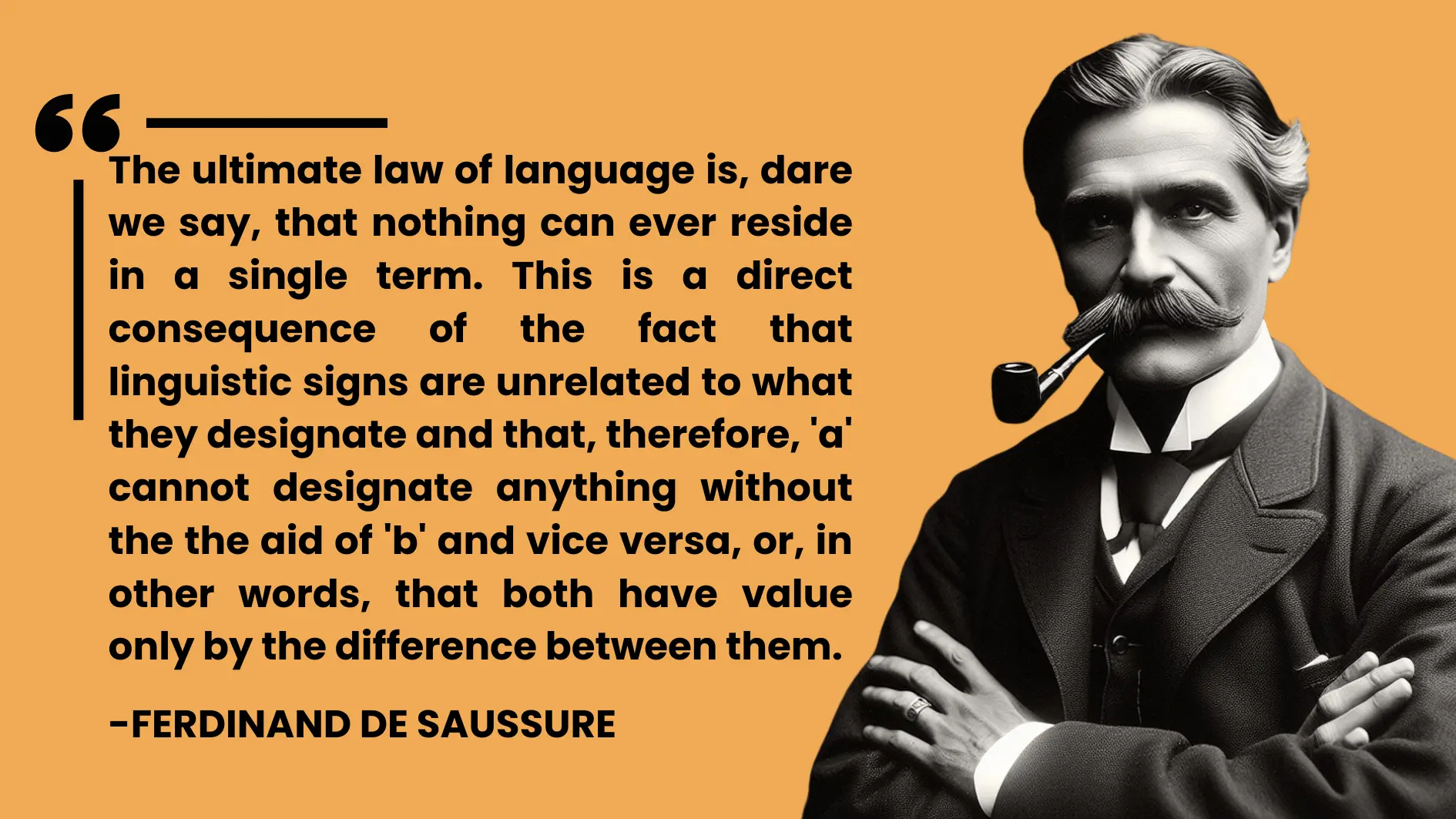Let’s start with the building block “Sign” before moving to Signifier and Signified!
Imagine you’re driving down a quiet road, enjoying the scenery. Suddenly, a bright red octagon with a white stop sign in the middle catches your eye.🛑

In that instant, a powerful message is conveyed: stop! This familiar symbol, a simple sign, triggers a mental image of brakes being applied, cars coming to a halt, and potential danger averted. But what exactly is happening here?
The Swiss linguist Ferdinand de Saussure, a pioneer in the field of semiotics, offered a fascinating framework to unravel this mystery. His groundbreaking concept of the “sign” lies at the heart of understanding how language works and how we make meaning through it. In this blog, we will read about Sign, Signifier and Signified about the proponent and at the end we will understand with some cool examples. Let’s dive deep into it!
Table of Contents
Who Was Ferdinand de Saussure?
Ferdinand de Saussure, a Swiss linguist born in 1857, is regarded as one of the founding figures in modern linguistics and semiotics. His groundbreaking contributions reshaped the way scholars perceive language and its structure, establishing the foundations for structuralism and semiotic theory.

Contributions to Linguistics
Saussure’s most influential work, posthumously compiled in “A Course in General Linguistics,” (1915) challenged traditional views on language. He shifted the focus from historical linguistics (the study of language evolution) to synchronic linguistics (the study of language at a specific point in time), fundamentally altering the field.
One of his key contributions was the differentiation between langue (language as a system) and parole (actual instances of speech). Saussure emphasized that understanding the underlying structure of langue was crucial to comprehending how language operates.
His second key contribution to his legacy is the theory of the sign, which revolutionized linguistic and semiotic studies. He proposed that language operates through signs, each consisting of two inseparable components: Signifier and Signified.
The concept of Signifier and Signified transformed how language and signs were perceived. It laid the groundwork for understanding that meaning in language arises from the relationships between signs rather than from inherent connections between words and their meanings.
Understanding the Components: Sign, Signifier and Signified
Ferdinand de Saussure’s theory of the sign comprises three integral components: the sign, the signifier, and the signified. Each element plays a crucial role in shaping our understanding of how language operates and how meaning is conveyed through signs.
The Sign
Definition: Saussure conceptualized a sign as a fundamental unit of language, composed of two inseparable parts—the signifier and the signified.

Example: Consider the word “apple.” Here, the entire concept of “apple” constitutes a sign, comprising both the spoken or written word (“apple” as the signifier) and the mental image or idea associated with the word (“apple” as the signified).
The Signifier
Explanation: The signifier refers to the physical form of the sign, such as spoken sounds, written words, or visual symbols.

Example: In the case of a traffic signal, the red colour itself (as the signifier) signifies the action “stop.” The colour red is the physical component conveying the message.
💡What truly makes signifiers intriguing is their arbitrary nature. There's no inherent link between the physical form and the meaning it carries. Why does the word "cat" refer to a furry feline, while "dog" conjures up a loyal canine companion? It's all a matter of cultural agreements and shared understandings that we inherit and weave into the fabric of our communication.
🤔Think about emojis, those tiny faces and symbols (😊😉😂) that have become an integral part of our digital conversations. A yellow smiley face doesn't inherently represent happiness, but through shared understanding, it has become a universal symbol of joy. And while the raised thumbs-up gesture could have meant disapproval in another culture, it has become a synonym for "good job" or "thank you" in many parts of the world.
The Signified
Understanding: The signified represents the concept, meaning, or mental image evoked by the signifier.

Example: Continuing with the traffic signal example, the concept of “stopping” (as the signified) is the mental association triggered by the signifier (the red colour). This mental link between the signifier and the concept is what guides our behaviour on the road.
💡The signified, however, is not a fixed entity. It's fluid, shaped by our individual experiences, cultural contexts, and even personal interpretations. For a child, the red light might represent a playful pause in a game, while for an anxious driver, it could trigger a wave of stress. The beauty lies in this very subjectivity, in the way each of us dances with the signified, creating our unique interpretations.
😶🌫️Imagine the word "home." For some, it might evoke a cosy cottage nestled in the woods, filled with the aroma of baking bread. For others, it might be a bustling city apartment, alive with the sounds of laughter and conversations. The signified is not a singular image, but a kaleidoscope of possibilities, each painted with the brushstrokes of our personal experiences.
Relationship between Signifier and Signified
Saussure emphasized the arbitrary nature of the relationship between the signifier and the signified. He argued that there’s no inherent connection between the physical form (signifier) and the meaning (signified) it represents. Instead, these associations are established and upheld by societal conventions within a particular linguistic community.
For instance, in different languages, the signifiers for the same concept (signified) can vary significantly. The English word “dog,” the French word “Chien,” and the Spanish word “perro” all signify the same concept (the domesticated animal), yet they differ in their signifiers due to linguistic conventions.
Role of Language and Culture
Saussure highlighted the influence of language and culture in shaping the relationship between signifiers and signifieds. Different languages and cultures may assign different signifiers to the same signified, illustrating how societal conventions impact the construction of meaning within a linguistic community.

Understanding these components offers a profound insight into the structure of language, emphasizing the interconnectedness of signs and the crucial role of societal conventions in establishing meaning within communication systems.
💡In different cultures, the association between colours and emotions can vary. For instance, while in Western cultures, the colour white often symbolizes purity and weddings, in some Eastern cultures, it represents mourning and funerals.
💡Similarly, the colour red might signify danger in many cultures, but in Chinese culture, it's associated with luck and happiness, especially during festivals like Chinese New Year.
Principles of Language: Arbitrariness, Relationality, and Systematicity
Based on the above, we can conclude that any words in a language do not refer us to reality, but to other words from which they are different. Hence, language is a system that keeps referring. We can now summarise that into principles regarding language:
Arbitrariness, one of Saussure’s key principles, underscores the lack of inherent connection between the signifier and the signified. In other words, there’s no natural or logical link between the sound or shape of a word and its meaning. This concept challenges the idea of a direct, predetermined relationship between linguistic symbols and their referents, highlighting the arbitrary nature of language.
Furthermore, Saussure emphasized the Relationality of signs, emphasizing that the meaning of a sign arises from its relation to other signs within the linguistic system. Language operates as a network of interconnected signs, where each sign gains significance through its contrast with and differentiation from other signs.
Systematicity, the third pillar of Saussure’s theory, highlights the structured and organized nature of language. It refers to the systematic arrangement of signs within a language, governed by rules and conventions that shape linguistic expression. This systematic structure enables individuals to comprehend and produce an infinite variety of meaningful utterances.
Conclusion
Ferdinand de Saussure’s theory of the sign, with its components—the signifier and the signified—has left an indelible mark on linguistics and semiotics. His principles of Arbitrariness, Relationality, and Systematicity continue to shape our understanding of language, emphasizing the arbitrary nature of linguistic signs, the importance of their relationships, and the systematic structure inherent in language.
Read Criticism and Modern Application of Saussure’s Theory for more details.

